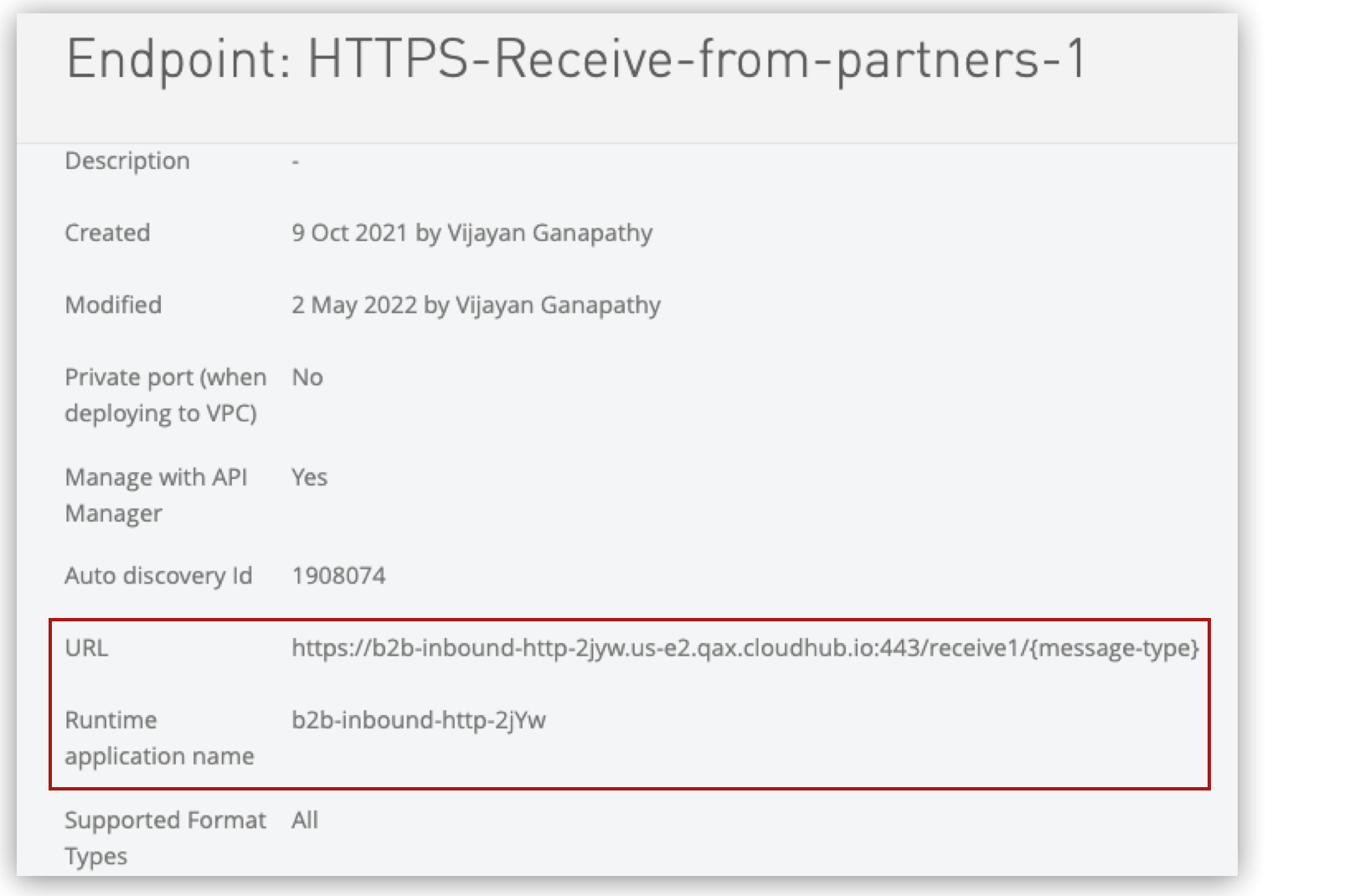
Deploying AS2, HTTP, and HTTPS Receive Endpoints
You can deploy AS2 receive, HTTP receive, and HTTPS receive endpoints on a public or private port.
Deploy to CloudHub 1.0 on a Public Port
When an AS2 or HTTPS receive endpoint is deployed to CloudHub with the private port configuration disabled, the endpoint application is deployed on the public HTTPS port (8082) or HTTP port (8081), with the traffic routed through the shared load balancer. The value in the URL field is automatically generated when you deploy a message flow that uses this endpoint.
You can view the runtime application name and external URL for a deployed endpoint from the endpoint details page. For example:

You can share the external URL with the partners that send AS2, HTTP, or HTTPS messages to this endpoint.
If your organization uses Anypoint Virtual Private Cloud without a dedicated load balancer (DLB), your organization’s platform administrator can configure the necessary Anypoint VPC firewall rules to allow specific partner or third-party connection IP addresses to access the endpoint.
Deploy to CloudHub 1.0 on a Private Port
To deploy an AS2, HTTP, or HTTPS receive endpoint to CloudHub 1.0 with the private port configuration enabled, you can:
-
Deploy a message flow that includes the receive endpoint.
-
Set CloudHub to automatically deploy newly created endpoints to a private port, as described in Configuring CloudHub 1.0 Deployment Settings.
Endpoints with the private port configuration enabled are deployed to the private HTTPS port 8092 or HTTP (only for AS2) port 8091. You can view the runtime application name, internal URL, and external URL for a deployed endpoint from the endpoint details page, which you can access from the <*host*> page (AS2 endpoints) or partner page (HTTP or HTTPS endpoints), or from a message flow.
Once an endpoint is deployed, follow these steps:
-
Configure URL mapping rules to forward the messages received from your partners to an application, as described in the following sections and in Dedicated Load Balancer Mapping Rules.
-
Have your organization’s platform administrator add your partner’s IP addresses to a list of allowed addresses in the DLB setting, as described in Dedicated Load Balancer Allowlists.
Deploy to CloudHub 2.0
Partner Manager deploys AS2 and HTTP inbound endpoints on CloudHub 2.0 with a HTTPS listener.
-
When using a shared space as the deployment target, the endpoints are accessible over the Internet and HTTP requests aren’t allowed.
-
When using a private space as the deployment target, you can use CloudHub 2.0 networking configurations, such as Ingress and Firewall rules, to manage and route incoming requests to your runtime applications.
-
If you want to allow HTTP requests to the AS2, HTTP, or HTTPS inbound endpoint application:
-
Use a private space as the deployment target.
-
On the Advanced tab, select
Accept HTTPin the HTTP requests field. -
Optionally, configure Network-Level Ingress Rules to allow HTTP requests from specific IP addresses.
-
-
External URLs and Mapping Rules for Deployed Receive Endpoints
The external URLS for receive endpoints deployed to public or private ports vary depending on the endpoint type, DLB domain, and input start_paths. You can share external URLs with your partners.
External URL and Mapping Rules for an AS2 Receive Endpoint
The external URL for an AS2 receive endpoint is https://{DLB-domain}/{Input-path}/receive-as2.
For example, if the name of your DLB domain is mythical.lb.anypointdns.net and the runtime application name is b2b-inbound-as2-zap3, your administrator can add a URL mapping rule in the DLB settings to forward incoming requests to the runtime application within your Anypoint VPC:

With this configuration, the external AS2 endpoint URL is https://mythical.lb.anypointdns.net/as2/mythical/receive-as2/.
External URL and Mapping Rule for an HTTPS Receive Endpoint
The external URL for an HTTPS endpoint is https://{DLB-domain}/{Input-path}/{base-path}/{message-type}.
For example, if the name of your DLB domain is mythical.lb.anypointdns.net, the base path you configured for the endpoint is send2, and the runtime application name is b2b-inbound-http-ognq, then your administrator can add a URL mapping rule in the DLB settings to forward incoming requests to the runtime application within your Anypoint VPC. For example:




